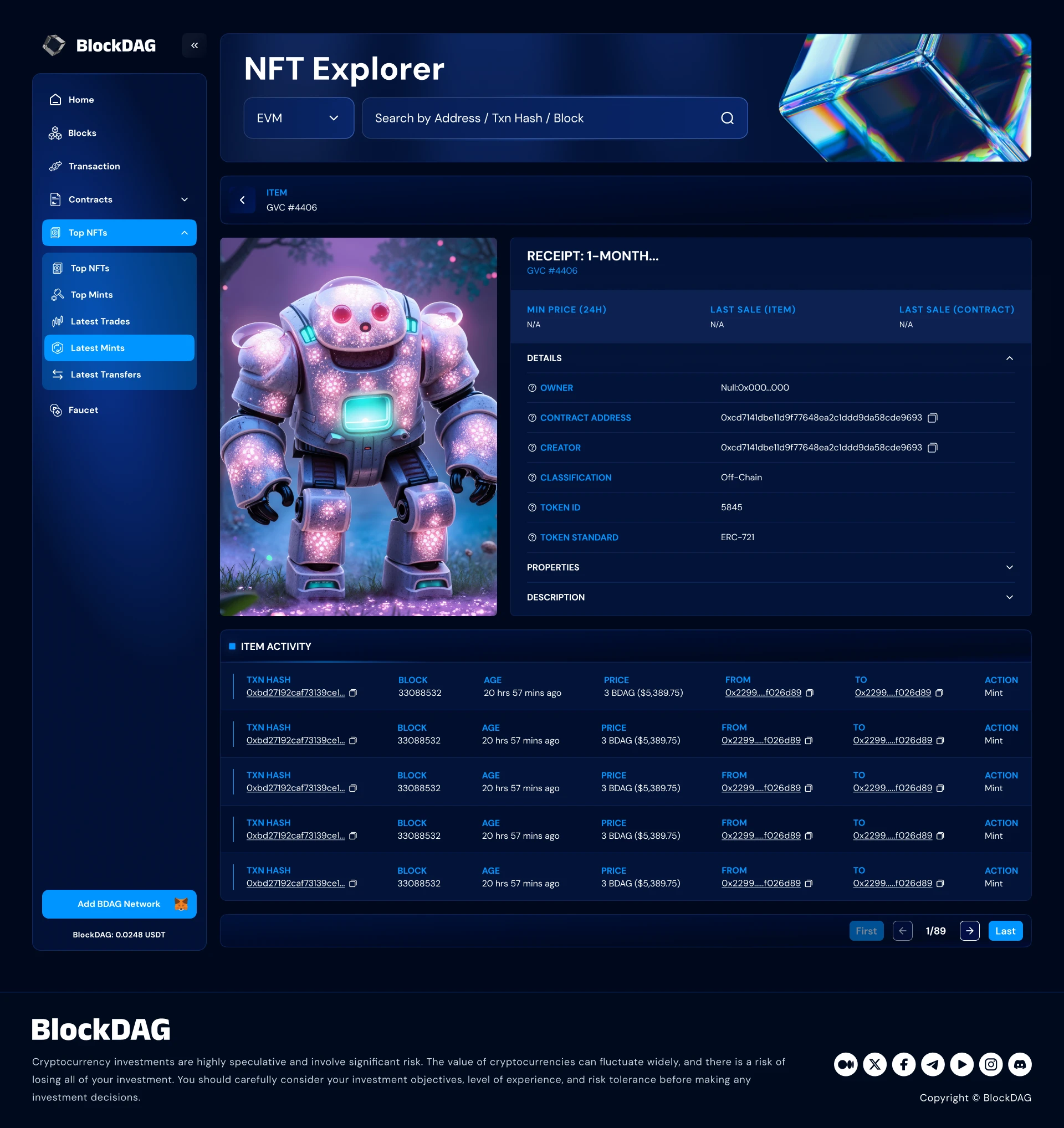Dev Release-213
Expanding Stats, Powering Governance & Reinventing Infrastructure in BlockDAG
Purpose
Key Highlights
Explorer Updates
Blockchain Core Updates
Open Issues
Closed Issues
What’s Next
Feedback & Collaboration
Final Thoughts
Expanding Stats, Powering Governance & Reinventing Infrastructure in BlockDAG
This release delivers a major stride forward in BlockDAG’s evolution from real-time statistical analytics in the Explorer to robust infrastructure for decentralized governance and developer flexibility. At the heart of this update is the introduction of a Stats & Charts module a dynamic analytics dashboard that brings transparent, real-time visibility into network activity. On the backend, the ecosystem is being fortified with WebSocket-based governance monitoring, a versatile nodeworker binary, and deep refactoring of the EVM Worker logic to support NFT scalability and runtime resilience.
While our engineering team tackles remaining issues around NFT supply and event tagging, we're also closing critical bugs like the mining timer reset to ensure accurate session tracking. Every component of this release contributes to a more transparent, developer-ready, and community-driven ecosystem.
Purpose
To deliver high-impact analytics, robust protocol observability, and enhanced developer tools, while paving the way for seamless governance, smarter runtime management, and powerful user-facing transparency through the Explorer.
Key Highlights
- Launch of a dynamic Stats & Charts analytics module in the Explorer
- WebSocket-based event monitoring for on-chain governance contracts
- Development of nodeworker binary for flexible BlockDAG node lifecycle control
- EVM Worker enhancements for scalable NFT handling and precise contract execution
- Bug fixes around mobile mining timer accuracy and supply visibility
Explorer Updates
Introducing the “Stats & Charts” Module
We’re proud to unveil the all-new Stats & Charts module, an interactive analytics interface integrated directly into the BlockDAG Explorer. This module aims to transform how users, developers, and validators perceive blockchain data. It lives just below the Transaction section in the navigation bar and opens a real-time dashboard that reflects the pulse of the entire network. Currently, the development team is working on this feature to make it accessible to the community.
Core Metrics Tracked
- Total Accounts:
Displays the current count of unique wallet addresses generated on the BlockDAG chain. Behind the scenes, this data is derived from indexed address creation events parsed from block headers and synced with the Explorer cache every few seconds. - Total Transactions:
Reflects the cumulative number of transactions recorded on the chain. This includes wallet transfers, contract deployments, mint/burn events, and NFT actions. The Explorer dynamically syncs this number by counting successfully confirmed tx hashes across all safe blocks. - Daily Coin Transactions:
A time-series visualization charting the volume of transactions processed per day. This graph supports zooming, date-range filtering, and adaptive granularity (hourly/daily/weekly). The backend processes this using MapReduce operations on indexed block data. - Price Analytics (Beta):
Integrates pricing data feeds (e.g., oracle-based or external market index via future modules) to show token price trends over time. Even though the token is in early lifecycle, this groundwork sets the stage for later on-chain DEX integrations and price feeds.
Technical Architecture
- Data Layer:
All metrics are aggregated via a dedicated analytics service, powered by a combination of time-series databases (e.g., InfluxDB) and an ETL pipeline that indexes block metadata in near-real-time. - Frontend Rendering:
Built using a reactive charting library with support for animations, dynamic tooltips, and state-preserving filters, ensuring responsiveness even as data scales. - API Endpoints:
A new /stats API endpoint is introduced, with parameters like interval=day/week/month, and optional filters for token types, contract interactions, or even address-specific insights (coming soon). - Caching & Performance:
Leveraging edge caching and delta updates, stats are refreshed efficiently without placing additional load on the core full nodes or Explorer database.
Blockchain Core Updates
WebSocket Monitoring for Governance Contract Events
Real-time governance needs real-time visibility. We’ve currently working on WebSocket-based monitoring service that actively listens to all emitted events from the Governance Smart Contract are currently in development phase.
Events Monitored
- ProposalCreated: Captures details of a submitted proposal including proposer, description, and required quorum.
- VoteSubmitted: Records wallet addresses that vote and their chosen stance.
- UpgradePassed: Automatically triggered when a proposal passes and the upgrade is queued.
- ProposalCancelled and VoteRevoked: Handles exceptions or retractions in the governance flow.
Implementation Details:
- Each Explorer miner maintains a persistent WebSocket connection to one or more full nodes.
- A subscription handler listens for logs matching governance event topics (derived from the contract ABI).
- Events are batched and streamed to a governance indexer for audit logs, visual analytics, and alerting.
- Support for event replay ensures missed messages are synced on restart.
This system provides the backbone for live governance dashboards and automated upgrade signals. It also opens up future use cases such as decentralized voting alerts, governance activity scoring, and voter engagement reports.
Nodeworker Binary for BlockDAG Node Execution
As part of our infrastructure modernization efforts, we’ll be releasing the nodeworker, a lightweight binary designed to wrap and launch BlockDAG nodes with runtime flags and enhanced operational control.
Key Features:
- Flag Support: Launch with custom flags such as syncmode, rpc-port, enable-metrics, dev-mode, and more.
- Preset Profiles: Switch between development, staging, and production profiles using env.
- Script-Friendly: Designed for CLI automation, CI/CD deployment, and container orchestration (e.g., Docker, Kubernetes).
- Lifecycle Management: Start, stop, restart, and status-check commands built-in.
Security & Config:
Supports loading .env or JSON config files with RPC secrets, and chain parameters.
Uses a fail-safe daemonization mode to prevent unintentional process exits in production environments.
EVM Worker Refactor & NFT Scalability
We’ve deeply refactored the EVM Worker, the module responsible for executing contract calls, parsing ABI outputs, and handling logs, especially in light of NFT and token-intensive usage patterns.
Key Improvements:
- Optimized Runtime: Reduced memory footprint and improved queue handling to support bursty transaction loads from NFT mints and DEX interactions.
- Dynamic ABI Handling: Auto-load ABIs at runtime for new contracts to improve function/event decoding without requiring pre-registration.
- Concurrent Execution Pipelines: Implemented multi-threaded processing of parallel contract executions to handle NFT bulk mints without bottlenecks.
- Custom Revert Messaging: Developers can now see granular revert messages on Explorer UI, helping in faster debugging of smart contract errors.
With more NFT projects expected on the BlockDAG chain, these enhancements set the foundation for high-volume throughput and advanced contract support in the runtime layer.

Open Issues
Scientific Notation for Large Minted Values
Quantities like 1e+21 are displayed in scientific notation in transaction summaries, which isn’t user-friendly. A fix is underway to format large numbers using readable suffixes (K, M, B, T) or digit grouping (e.g., 1,000,000,000,000,000,000,000).
Incorrect Method Labeling in Events Tab
The Events tab defaults to displaying "Transfer" even when a user calls mint() or burn() on an NFT contract. We're working on parsing method signatures from transaction input data to reflect the correct function name based on the ABI.
Burned NFT Quantities Not Reflected in Supply
NFTs burned by users do not affect the total supply shown in the UI. We're updating our backend sync logic to monitor Transfer events to the zero address and subtract that quantity from the circulating count.
Closed Issues
Fixed: Mining Timer Inaccuracy
The X10 mining timer bug that reset the timer to 24 hours on each stop/resume has been resolved. The app now retains accumulated mining time accurately across sessions, ensuring correct reward tracking.
What’s Next
- Add interactive cohort-based analytics to the Stats module
- Launch governance dashboards with real-time vote visualization
- Refine ABI parsing for event logs across all transaction types
- Display NFT images and metadata inline within transactions
- Begin testing EVM Worker multi-chain compatibility for future sidechain support
Feedback & Collaboration
We’re building BlockDAG openly. Whether you’re a miner, dApp developer, NFT creator, or protocol researcher your feedback is critical.
Email: [email protected]
Join: Dev forums, Testnet Discord, Feature Boards
Final Thoughts
This release is a leap forward in how BlockDAG communicates, monitors, and scales. With immersive analytics through the Stats & Charts module, real-time governance monitoring, and hardened backend infrastructure, we are laying the groundwork for a high-performance, community-led blockchain future.
Let’s continue to build the future of decentralized infrastructure block by block.
